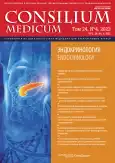Association of anthropometric parameters with the risk of developing type 2 diabetes in overweight or obese individuals: cohort prospective study
- Authors: Valeeva F.V.1, Khasanova K.B.1, Yilmaz T.S.1, Mansurova R.G.2
-
Affiliations:
- Kazan State Medical University
- City polyclinic №18
- Issue: Vol 24, No 4 (2022)
- Pages: 242-246
- Section: Articles
- URL: https://journals.rcsi.science/2075-1753/article/view/108921
- DOI: https://doi.org/10.26442/20751753.2022.4.201553
- ID: 108921
Cite item
Full Text
Abstract
Background. Type 2 diabetes mellitus (T2DM) is a non-infectious pandemic of the 21st century. The severity and complexity of this disease is associated with the development and progression of chronic complications that begin at the stage of early carbohydrate and fat metabolism disorders.
Aim. To identify the leading anthropometric predictors of the development of type 2 diabetes in overweight or obese patients with early carbohydrate metabolism disorders.
Materials and methods. The cohort prospective study involved 112 overweight or obese adults (all citizens of Russia, Republic of Tatarstan) aged 22 to 79. The study was carried out from 2016 to 2018 in the City polyclinic №18. R 4.1.0 environment was used for statistical analysis. Univariable and multivariable logistic regression modeling were performed to evaluate association between outcomes and possible predictors, odds ratios with 95% confidence intervals were estimated. Area under the ROC-curve and Nagelkerke pseudo R-squared was used to compare prognostic performance of predictors.
Results. During 3 years of follow-up of 112 patients –– with early carbohydrate metabolism disorders (prediabetes; n=64), without prediabetes (n=48) – without medical intervention, new cases of type 2 diabetes in people with prediabetes and obesity amounted to 29% (n=18) compared with 6% (n=3) for patients with normal glucose levels. The ratio of waist circumference to height (WHtR) and the ratio of waist to hip circumference (WHR) had the greatest discriminative ability according to univariate and multifactorial analyses.
Discussion. Our study is consistent with previous work indicating a negative impact of visceral adipose tissue on the risk of developing T2DM. WHR and WHtR most accurately reveal the visceral type of obesity. WHR and WHtR are statistically significant parameters for assessing the risk of developing T2DM according to our study.
Conclusion. WHR and WHtR can be used as predictors of type 2 diabetes in overweight or obese individuals.
Full Text
##article.viewOnOriginalSite##About the authors
Farida V. Valeeva
Kazan State Medical University
Email: kamilya_khasanova@mail.ru
ORCID iD: 0000-0001-6000-8002
D. Sci. (Med.), Prof.
Russian Federation, KazanKamilya B. Khasanova
Kazan State Medical University
Author for correspondence.
Email: kamilya_khasanova@mail.ru
ORCID iD: 0000-0003-1825-487X
Assistant
Russian Federation, KazanTatyana S. Yilmaz
Kazan State Medical University
Email: kamilya_khasanova@mail.ru
ORCID iD: 0000-0002-0003-1283
Cand. Sci. (Med.)
Russian Federation, KazanRezida G. Mansurova
City polyclinic №18
Email: kamilya_khasanova@mail.ru
Chief doctor
Russian Federation, KazanReferences
Supplementary files







